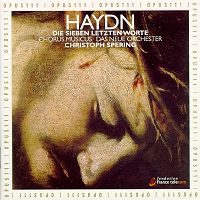|
<< -- 3 -- Robert Anderson POPULAR ESTEEM

It was perhaps inevitable that the Seven Last Words should eventually
become an oratorio. On his second journey to England in 1794 Haydn heard
an attempt at adding choral parts to the work by Joseph Friebert of Passau.
He knew he could do better himself. He approached Baron van Swieten for
revision of the words, which he used to provide parts for soloists and chorus.
Before each sonata the relevant 'word' was to be declaimed in
simple block harmony. Haydn made other changes. He added clarinets and trombones
to the original orchestra; he omitted all repeats and he composed a second
'Introduzione' for wind alone after Sonata 4.

The result is a greatly increased expressive range, with text that nowhere
jars against the 'word' that follows. Sonata 2, for instance,
shows Haydn at his most sensitive [listen -- track
3, 1:24-2:00]. The new 'Introduzione' completely recaptures
the mood of ten years earlier and demonstrates Haydn in full command of
his additional woodwind and trombones [listen --
track 6, 0:30-1:30]. Chorus and orchestra under Christoph Spering respond
splendidly, as do the soloists, to all Haydn's demands. Perhaps nothing
is more moving in this final version of the work than the lovely textures
displayed in Sonata 5, 'I thirst' [listen
-- track 7, 0:40-1:50].
Copyright © 18 November 2000
Robert Anderson, London, UK
 CD INFORMATION - CLAVES CD 50-2002 (QUARTET)
PURCHASE CD 50-2002 (QUARTET) FROM CROTCHET
CD INFORMATION - OPUS 111 OPS 30-284 (ORATORIO)
PURCHASE OPS 30-284 (ORATORIO) FROM AMAZON
PURCHASE OPS 30-284 (ORATORIO) FROM CROTCHET
<< Music
& Vision home
Howard Hanson >>
CD INFORMATION - CLAVES CD 50-2002 (QUARTET)
PURCHASE CD 50-2002 (QUARTET) FROM CROTCHET
CD INFORMATION - OPUS 111 OPS 30-284 (ORATORIO)
PURCHASE OPS 30-284 (ORATORIO) FROM AMAZON
PURCHASE OPS 30-284 (ORATORIO) FROM CROTCHET
<< Music
& Vision home
Howard Hanson >>
 |
To listen to the aural illustrations in this review,
you may need to download RealNetworks' realplayer 8. |
|

